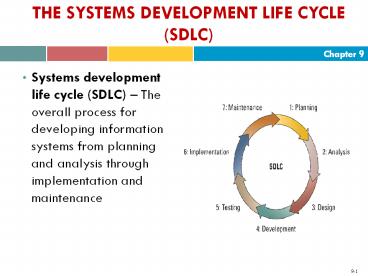THE SYSTEMS DEVELOPMENT LIFE CYCLE (SDLC) PowerPoint PPT Presentation
Title: THE SYSTEMS DEVELOPMENT LIFE CYCLE (SDLC)
1
THE SYSTEMS DEVELOPMENT LIFE CYCLE (SDLC)
- Systems development life cycle (SDLC) The
overall process for developing information
systems from planning and analysis through
implementation and maintenance
2
SOFTWARE DEVELOPMENT METHODOLOGIES
- There are a number of different software
development methodologies including - Waterfall
- Agile
- Rapid application development (RAD)
- Extreme programming
- Rational unified process (RUP)
- Scrum
3
Waterfall Methodology
- Waterfall methodology A sequence of phases in
which the output of each phase becomes the input
for the next
4
Agile Methodology
- Iterative development Consists of a series of
tiny projects - Agile methodology Aims for customer
satisfaction through early and continuous
delivery of useful software components developed
by an iterative process using the bare minimum
requirements
5
Rapid Application Development Methodology (RAD)
- Rapid application development methodology
Emphasizes extensive user involvement in the
rapid and evolutionary construction of working
prototypes of a system to accelerate the systems
development process - Prototype A smaller-scale representation or
working model of the users requirements or a
proposed design for an information system - The prototype is an essential part of the
analysis phase when using a RAD methodology
6
Extreme Programming Methodology
- Extreme programming (XP) methodology Breaks a
project into tiny phases, and developers cannot
continue on to the next phase until the first
phase is complete
7
Rational Unified Process (RUP) Methodology
- Rational unified process (RUP) Provides a
framework for breaking down the development of
software into four gates - Gate one inception
- Gate two elaboration
- Gate three construction
- Gate four transition
8
SCRUM Methodology
- Scrum Uses small teams to produce small pieces
of deliverable software using sprints, or 30-day
intervals, to achieve an appointed goal - Under this methodology, each day ends or begins
with a stand-up meeting to monitor and control
the development effort
9
DEVELOPING SUCCESSFUL SOFTWARE
- Primary reasons for project failure
- Unclear or missing business requirements
- Skipping SDLC phases
- Failure to manage project scope
- Scope creep
- Feature creep
- Failure to manage project plan
- Changing technology
10
DEVELOPING SUCCESSFUL SOFTWARE
- The later in the SDLC an error is found the more
expensive it is to fix!
11
MANAGING SOFTWARE DEVELOPMENT PROJECTS
- Analysts predict investment in MIS projects
worldwide is more than 1 trillion - 70 percent will be lost due to failed projects
- The consequences of failed projects include
- Damaged brand
- Lost goodwill
- Dissolution of partnerships
- Lost investment opportunities
- Low morale
12
MANAGING SOFTWARE DEVELOPMENT PROJECTS
- Project deliverable Any measurable, tangible,
verifiable outcome, result, or item that is
produced to complete a project or part of a
project - Project milestone Represents key dates when a
certain group of activities must be performed - Project management office (PMO) An internal
department that oversees all organizational
projects
13
The Triple Constraint
- Project Management Interdependent Variables
14
The Triple Constraint
- Benjamin Franklins timeless advice - by failing
to prepare, you prepare to fail - applies to
software development projects - The Hackett Group analyzed 2,000 companies and
discovered - 3 in 10 major IT projects fail
- 21 percent of the companies state that they
cannot adjust rapidly to market changes - 1 in 4 validates a business case for IT projects
after completion
15
Project Participants
- Project Management Role
16
UNDERSTANDING PROJECT PLANNING
- SMART criteria are useful reminders on how to
ensure that the project has created
understandable and measurable objectives
17
UNDERSTANDING PROJECT PLANNING
- Two primary diagrams used in project planning
include PERT and Gantt charts - PERT chart
- Dependency
- Critical path
- Gantt chart
18
UNDERSTANDING PROJECT PLANNING
- PERT Chart EXPERT PERT Chart Example
19
UNDERSTANDING PROJECT PLANNING
- MS Project Gantt Chart Example
20
MANAGING PROJECTS
- Managing a project includes
- Identifying requirements
- Establishing clear and achievable objectives.
- Balancing the competing demands of quality,
scope, time, and cost - Adapting the specifications, plans, and approach
to the different concerns and expectations of the
various stakeholders
21
OUTSOURCING PROJECTS
- In-sourcing (in-house-development) Uses the
professional expertise within an organization to
develop and maintain its information technology
systems - Outsourcing An arrangement by which one
organization provides a service or services for
another organization that chooses not to perform
them in-house
22
OUTSOURCING PROJECTS
- Factors driving outsourcing growth include
- Core competencies
- Financial savings
- Rapid growth
- The Internet and globalization
23
OUTSOURCING PROJECTS
- Onshore outsourcing
- Nearshore outsourcing
- Offshore outsourcing
24
OUTSOURCING PROJECTS
- Most organizations outsource their noncore
business functions, such as payroll and IT

